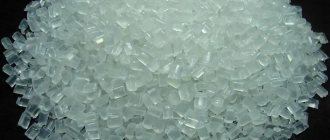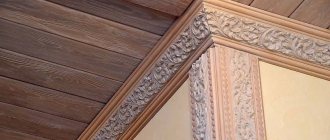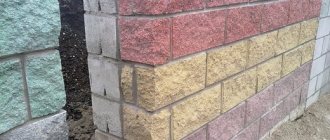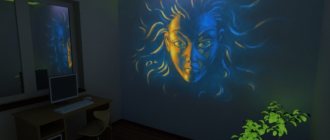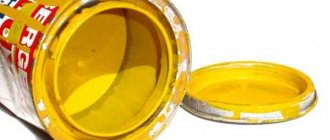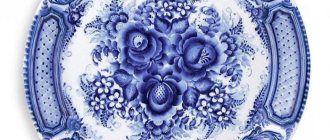Due to its properties, acrylic paint is a worthy material for repairing external and internal surfaces. It is easy to use, light and moisture resistant, and has unique properties depending on its purpose.
Read more about the types and properties of acrylic paint here.
Some manufacturers produce ready-made paint in a wide range of colors. Others only produce a white acrylic base for a variety of design options. In this connection, the question arises: “Is it possible to tint acrylic paint?” The answer is, of course, yes. Thanks to the large selection of colors for acrylic, you can create any unique shade.
Production and origin
Acrylic paints appeared on the market relatively recently. Scientists, in the process of splitting acrylic acid, were able to isolate a substance that became the basis for the manufacture of the polymer. It is a pure synthetic material. It has a transparent texture and excellent technical properties. The material does not have a pungent odor. It is very durable, tolerates thermal changes well, and is not afraid of ultraviolet radiation.
Using acrylic resins, manufacturers have learned to produce paints and paints. They prepare a solution, add a polymer dispersion, a binder, and a coloring pigment to it. The result is a material, after application of which a film is formed on the surface being treated that can protect against external factors. This paint adheres very well to the base and has a high degree of adhesion. Its quality depends on the type of acrylic resin and the fillers used. With their help, the viscosity of the paint and its matting are “formed”.
Polymer base for the production of acrylic paints Source svopi.ru
This indicator is adjusted by adding a solvent. When deciding how to dilute acrylic paint, you need to carefully study the manufacturer's instructions. The main parameters of the composition are indicated there, the scope of its use is indicated, and the main stages of preparing the paint for construction work are listed. The composition of acrylic paints provides their advantages:
- They are environmentally friendly and do not contain substances hazardous to human health.
- They are easy to work with, the compositions are applied in an even layer and dry quickly.
- The paints are odorless, so you can work with them even indoors.
- The materials are not prone to fire, they do not contain flammable substances.
- The ability to add pigments allows manufacturers to produce paints in a wide color palette. Today, using them you can not only paint various types of surfaces, but also create colorful paintings. What makes artists who paint walls and ceilings happy?
Acrylic paint colors Source giveart.ru
- The time for complete drying of one layer is three hours.
- After application, a film that is resistant to abrasion is formed on the surface. The color does not fade in the sun.
- The painted surface does not lose its attractiveness for ten years.
- The composition of the paint is unique; after application, its layer reliably protects the surface from moisture, while it allows air to pass through well.
- Painted areas are easy to clean, dirt particles do not stick to them, so the maintenance process is noticeably simplified.
Versatility and versatility provide a wide range of applications. Experts, talking about what acrylic paints can be used for, draw attention to the fact that they can paint metal and wood, concrete, a layer of decorative plaster and even fabric. With their help, tuning of passenger cars is carried out. They are used by manicurists and pedicurists to create amazing nail designs. There are restrictions on some types of plastic, but otherwise there are no prohibitions.
Wall art painting Source remstatus.ru
See also: Catalog of house projects for which painting was used.
What is a color for acrylic paint?
Color for acrylic paint is a dye concentrate made in the form of a paste, powder or liquid. It is added to a white or transparent base in a certain amount recommended by the manufacturer.
There are the following forms of colors:
- Liquid colors allow you to get a shade of any complexity, so they are the best option when creating colors for artistic painting of walls and ceilings.
- Pastes are easy to use, but due to their saturation and imprecise color characteristics, it can be difficult to create the expected shade.
- Powders are affordable, but not always convenient to use.
Colors can be organic and inorganic, glossy, matte, with mother-of-pearl, etc.
Read more about the types of colors in another article on our website.
Types of colors by composition
Types of paints
By mixing different proportions of the main components and adding additives, it is possible to create compositions for different surfaces. Acrylic paints for exterior use are available for sale. They contain substances that improve resistance to fading in the sun; their consistency is more similar to enamels. They are used to paint any surface that is located on the street: house facades, fences, gates.
In interior paints there are significantly fewer components that improve UV resistance. Antiseptics and fungicides can be added to them and prevent the formation of mold in places with high humidity.
If long-term work is planned, additives are added to the compositions to slow down the drying of the paint. They have a gel consistency. By using such components, it is possible to make technical breaks, and they do not in any way affect the quality of the finishing coating.
Weather-resistant acrylic facade paint Source ozon-st.cdn.ngenix.net
Note! Adding components can make the paint structure matte or glossy. Therefore, this must be taken into account before using them.
Metal paints are usually sold in aerosol form. To apply other types, it is better to use brushes with synthetic bristles or hard rollers.
See also: Catalog of companies that specialize in paints and varnishes and finishing works
Manual tinting
Acrylic enamel tinting can be done at home. The process includes several stages.
What will you need?
For tinting paint you will need the following materials and tools:
- White base. The quantity is calculated taking into account the surface area. Add 10% to the consumption indicated in the instructions. Take into account the need to apply several layers.
- Colors. The number of packages depends on the saturation of the desired color.
- Capacity. The paint is mixed in a basin or bucket.
- Mixer. The tool can be replaced with a drill with the required attachment.
- A small container for creating a test composition.
- Color dispensing tool. A pipette or syringe will do. Some dye bottles are equipped with dispensers.
Creating a Probe
Mixing acrylic paint.
This stage is necessary to calculate the required amount of color. The probe is created like this:
- A small amount of enamel is poured into the tray. Using a pipette, measure the required volume of color.
- The values are recorded and the composition is mixed until a uniform tone is obtained.
- The colorant is added until the desired color is obtained. The necessary information is recorded after each step.
The sample is prepared in the room where the renovation is being done. It must be taken into account that artificial and natural lighting reflects shades differently. The finished composition is applied to cardboard or plywood, after which it is inspected from different sides.
Getting the right shade
Add 4/5 of the pigment used for the sample to 1 liter of base paint. If 100 ml of enamel was mixed with 5 drops of dye, 40 drops are taken per 1 liter of base. To reduce brightness, the volume of color is reduced. After adding the pigment, the composition is thoroughly mixed with a construction mixer or drill. The nozzle should rotate at low speed.
It is not recommended to stir the paint using improvised means. The coating acquires defects in the form of stripes and spots. The composition is applied to cardboard and the resulting tone is assessed. The color can be made brighter by adding a small amount of color.
Application technology
In order to obtain a high-quality result, the surface to be painted must first be cleaned of dirt and dust, and then primed. To do this, it is better to use a special composition or white acrylic paint diluted in half with water. If you ignore this process, the consumption of the finishing coat will double (both acrylic paint on wood and any other type are well absorbed into the base). If it is pre-coated with primer, much fewer layers will need to be applied.
If there is an old layer of paint, it is better not to experiment, but to remove it completely with a spatula. If this work is not done carefully, the result will not please you: the acrylic compositions are applied in a very even thin layer, and the presence of any defect is only emphasized and exposed.
Preparing walls for painting Source mtdata.ru
The direction in which the first layer of paint is applied does not matter. If the material is used to decorate walls or ceilings, it is better to apply the finishing layer towards the window. Then the finish will look perfect.
Before applying acrylic, glass and metal surfaces must be wiped with an alcohol composition, which allows the surface to be degreased. Then the paint layer will lie flat, and after drying the coating will be very strong and durable.
To choose the right color, you need to try on a separate piece of the material being processed. The fact is that acrylic paint for wood, metal, glass becomes a little darker after drying. It is important to pay attention to the structure of the composition. It can be glossy, matte, translucent and completely transparent. After hardening, it will be impossible to correct defects.
Acrylic paint darkens slightly after drying Source roomester.ru
How to prepare the composition for painting
Any enamels must be diluted before application. Not everyone knows how to dilute acrylic paint. The manufacturer does not always indicate this item in the technical data sheet. If there is no additional information, you can dilute the paint with plain water. When the 1x1 ratio is selected, the ideal composition for priming the base is obtained.
If you need to apply a very thin layer that will lie evenly on the surface, experts advise adding two parts of water (200 ml per liter). The more water, the thinner the paint layer will be.
Note! The paint must be diluted in a separate container. You cannot pour water into the jar straight away. In such a situation, it will be difficult to control the consistency of the finished composition. Acrylic diluted with water cannot be stored. Once dry, it becomes unusable.
Water is the best base for acrylic paints Source kraskaok.ru
Hot boiled water is the best thinner for acrylic paints that are dried and unused. To “reanimate” them, you need to grind the dried paint into powder, and then pour boiling water into it. Leave for a few minutes, drain, and repeat the procedure again. After the paint has softened well, excess water is poured out, everything that remains in the container is thoroughly stirred. Of course, after such “reanimation” the material partially loses its properties, so experts do not recommend using it for painting “ceremonial” places. However, if you need to improve the appearance of an old shed, paint will do just fine.
Briefly about the main thing
Acrylic paints are water-dispersion compositions that contain polymers, water, pigments and additives that improve the technical properties of materials. They differ from similar products in that they help form a very thin color layer that is resistant to moisture and ultraviolet radiation. It allows air to pass through well. Has high wear resistance. You can paint any surface with acrylic paints. They have one drawback - the high price. But greater durability more than compensates for any expenses.
Ratings 0
What should you consider when tinting yourself?
When creating a shade yourself, consider the following points:
- Acrylic enamels used to renovate rooms have varying degrees of whiteness. The higher this value, the richer the tone.
- Paints and varnishes have markings that reflect their intended purpose. Materials marked “for ceilings” should not be used for painting walls. The working qualities of coloring agents differ. The choice of color depends on the type of white base.
- On a larger area the paint looks richer. Walls with openings have a darker shade. The textured surface looks different.
- A shiny coating reflects light well, so it is not recommended to give the paint a too bright tone.
